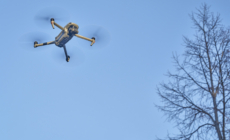-
Removing Carbon From the Sky Could Be the Next Climate Gold Rush - 24 mins ago
-
California’s rush to regulate AI has a 1st Amendment problem - 31 mins ago
-
Face of Shelter Dog Spending His Fourth Christmas Alone Breaks Hearts - 35 mins ago
-
The Enigma of Bob Dylan - about 1 hour ago
-
Toddler’s Guilt Trip Works to Perfection on Grandma: ‘Caved In Too Quick’ - about 1 hour ago
-
Newsom reads the election returns and heads to red California - about 1 hour ago
-
‘SNL’ Takes on New Jersey Drones: ‘Dumb Theories’ - 2 hours ago
-
A Woman With a Rare Gene Mutation Fights to Avoid Her Mother’s Fate - 2 hours ago
-
Newsom and a fellow Democrat spar over constitutional convention on gun control - 2 hours ago
-
Germany Christmas Market Latest: Suspect Remanded in Custody - 2 hours ago
China Turns Tables on US Ally Over ‘Unprofessional’ Fighter Jet Maneuver
China has defended the actions of an air force pilot who was accused of endangering an Australian helicopter crew during an air intercept over the weekend, arguing on Tuesday that the U.S. ally had deliberately sent the aircraft to disrupt a Chinese military exercise.
Zhang Xiaogang, a Chinese Defense Ministry spokesperson, said the Chinese military’s actions were “legitimate, reasonable, professional and safe,” according to a statement posted to its website.
Australia, part of the ANZUS security treaty with New Zealand and the United States, said a day earlier that a Chinese air force J-10 fighter jet had buzzed an MH-60R Seahawk on May 4 in the Yellow Sea, calling it “an unsafe and unprofessional interaction” in international airspace.
The U.S. has in recent years complained of several similar intercepts. Last fall, the U.S. Defense Department disclosed a series of maneuvers by Chinese aircraft that resulted in near misses with American air assets in international airspace.
Australia’s defense minister, Richard Marles, said the Chinese combat aircraft dropped flares 1,000 feet in front and 200 feet above the MH-60R, forcing the operator to “take evasive action in order not to be hit by those flares.”
“The consequence of being hit by the flares would have been significant,” Marles said.
Anthony Albanese, Australia’s prime minister, called the maneuver “unacceptable.”
The helicopter, whose crew was not harmed, was attached to the Australian navy destroyer HMAS Hobart, deployed to the region under Operation Argos, Canberra’s contribution to enforce U.N. Security Council sanctions on North Korea, Australia’s Defense Department said.
Zhang, the Chinese defense official, said the Hobart had “dispatched a ship-borne helicopter for three times to conduct close-in reconnaissance and disturb the normal training activities” of a Chinese naval fleet exercising in the Yellow Sea from May 3-4.
Chinese forces sent radio warnings to the Australian helicopter and later conducted “safe operations to expel it” in line with international practice, he said.
Also on Tuesday, China’s Foreign Ministry spokesperson Lin Jian said the Australian helicopter “deliberately flew within close range of China’s airspace in a provocative move that endangered China’s maritime and air security in the name of enforcing the U.N. Security Council’s resolutions.”
“The Chinese military took necessary measures at the scene to warn and alert the Australian side. The way the situation was handled was consistent with our laws and regulations, professional and safe,” Lin said.
Late last month, the maritime safety authority of Dalian, a port city on the Bohai Sea, the Yellow Sea’s innermost gulf, announced a no-go zone in the Bohai Strait from April 28 to May 5, citing a planned “military mission.”
The Chinese Defense Ministry did not say whether it was referring to the same exercise. It did not immediately respond to a written request for comment.
Australia’s Defense Department did not return an emailed request to comment on the Chinese response.

Australia Department of Defense/LSIS Matthew Lyall
Canberra is only the latest U.S. ally to lodge similar complaints, and it was the country’s most serious encounter with the Beijing’s military since Australian navy divers were said to have been injured in November by a Chinese destroyer’s sonar ping in the East China Sea.
In October, a Canadian aircraft, also enforcing U.N.-mandated sanctions on North Korea, was intercepted by a pair of Chinese fighter jets, one of which released flares in front of the plane.
U.S. officials have publicly acknowledged Beijing’s protest that American aircraft are operating “too close to China,” although never in Chinese airspace. Washington insists its military assets will fly and sail wherever international law allows.
The Pentagon did not respond to a written request for comment.
Uncommon Knowledge
Newsweek is committed to challenging conventional wisdom and finding connections in the search for common ground.
Newsweek is committed to challenging conventional wisdom and finding connections in the search for common ground.
Source link

















